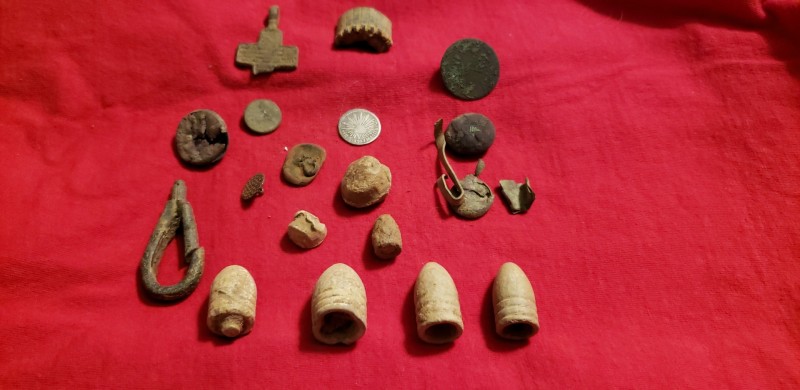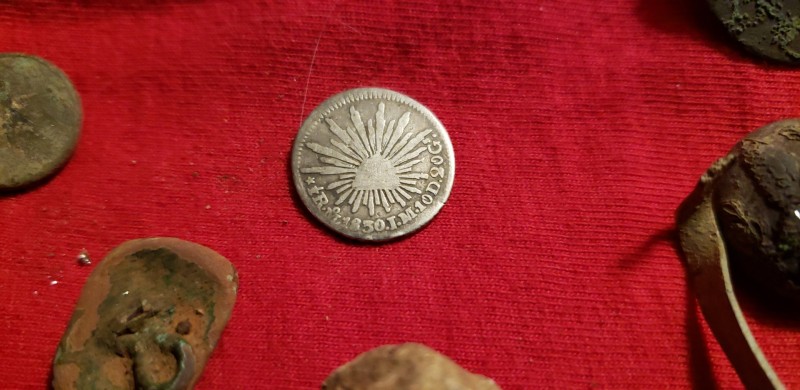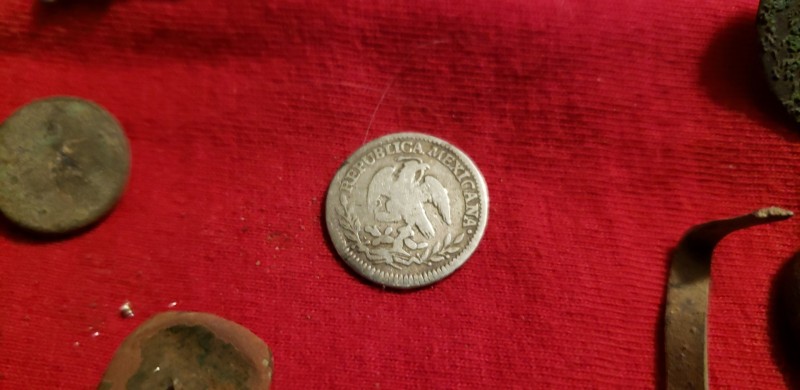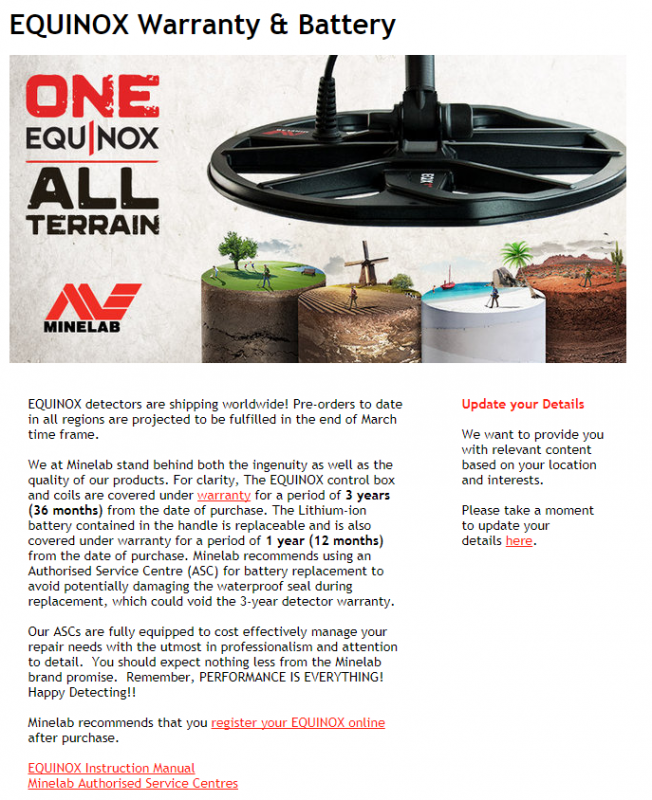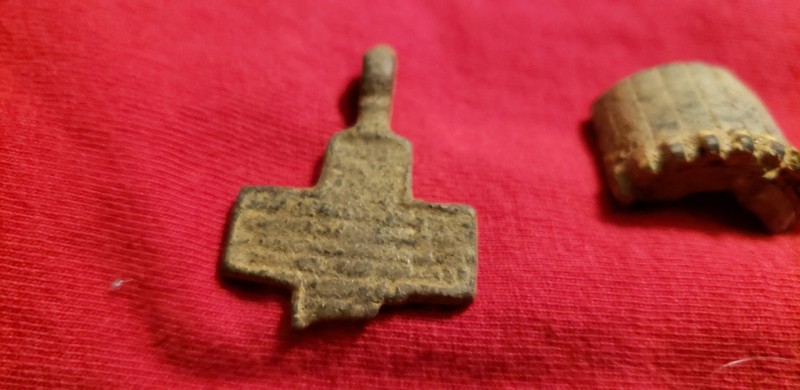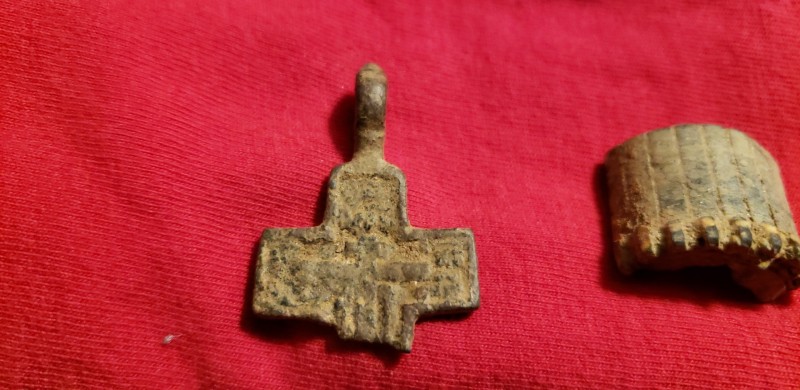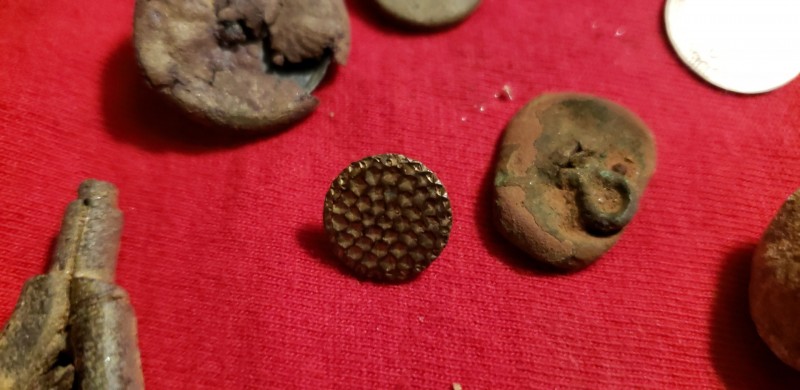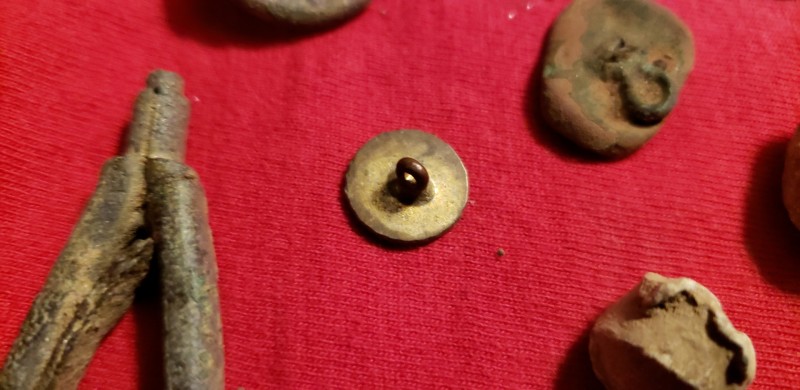-
Posts
6,119 -
Joined
-
Last visited
Content Type
Forums
Detector Prospector Home
Detector Database
Downloads
Everything posted by Chase Goldman
-

Small Audio Equalizer To Adjust Iron Audio?
Chase Goldman replied to kac's topic in Metal Detector Advice & Comparisons
Ok, I consider myself somewhat competent at using search engines and so forth, but for the life of me cannot get this gadget to pop up in any search phrase I use whether on google or at either Amazon or AliExpress. Any chance you could throw me a bone and post a link, manufacturer, or model number so I can check this out for myself. Much appreciated. -
There are some subtle differences and improvements that XP has made with the Gold Field program as implemented on ORX vs. Deus including switchable iron volume which does not exist on the Deus implementation of Gold Field plus I like the Orx pop up large font TID display and iron probability meter. Also, the ground grab implementation on the Orx is a little more straight forward on Orx. ORX lacks ground balance tracking, however. Overall, I am more and more impressed with ORX and Gary Blackwell's videos have unlocked some neat ORX secrets such as how to set up Gold Field properly for effective wet salt sand beach hunting that I can't wait to try out. One thing that Gary recommends in his field hunting skill video is cranking Iron Audio Reject (IAR) setting to the maximum setting of 5. That setting works well in mild ground, but is not effective in mineralized ground as it tends to chop up all signals due to the ferrous content of the mineralized magnetite in the soil. So just as he recommended on a wet salt sand ORX video at a beach that had a good deal of black sand mineralization, he set the IAR to 0.
-

The Correct Batteries For Beach Detecting
Chase Goldman replied to Steve Herschbach's topic in Metal Detecting For Jewelry
Nice product placement deal Garrett must have made with Duracell as the detector brand name is not obscured at all. Well played by the Garrett marketing team. Wish their engineering team was just as innovative. -
I like the coverage of the larger coil, but when it is all said and done for me, I pretty much am sticking with the stock coil even for beach detecting for many of the reasons mentioned above.
-

Amplifier & Speaker On The Cheap? Updated
Chase Goldman replied to GB_Amateur's topic in Detector Prospector Forum
Good point. The WM08 is a great external speaker port solution if you are solely using the Equinox. Unfortunately, however, the WM08 is not universal so if I want to use the same wireless method on both my Equinox and GPX, then BT APTX LL is the way to go and that is why I mentioned the BT LL APTX receiver/transmitter module that I can plug into my GPX as a transmitter for the Equinox wireless headphones or as a wireless receiver for amplified speakers and that I can universally use with either the GPX or Equinox. The Z-Lynk will work as well, but I am trying to minimize different systems so I have pretty much settled on the BT APTX LL universe as the wireless standard for my ML detectors. And an added benefit is that BT APTX LL hardware is comparably significantly less expensive than dedicated proprietary solutions such as Z-Lynk and ML's Pro Sonic system. -

Amplifier & Speaker On The Cheap? Updated
Chase Goldman replied to GB_Amateur's topic in Detector Prospector Forum
Chuck. Not sure what detector you plan to use your amplified speakers with, but if you are using the Equinox and have a way to fasten them to your suspenders or backpack straps as Doc mentioned, then the speaker (or speakers) can plug directly into your wireless headphones. In that configuration, the headphones can be flipped flat an rest on your neck/shoulder and they act as a bluetooth receiver but with the low latency sound coming through the amplified speaker vice the headphone speakers. I use a low latency bluetooth transmitter like the one below (about $29 US), that I can plug into the headphone jack of my GPX. That way I can use the same wireless headphones for my Equinox and my GPX depending on which detector I am using at the time. Works great. I mention this because you can use a low latency APTX BT receiver/transmitter in lieu of the headphones as your receiver for your amplified speakers. I don't see too many standalone BT speakers that also incorporate low latency APTX audio so they really do not work well for detecting. Just some ideas for you to kick around as you figure out your detecting speaker configuration. -

Small Audio Equalizer To Adjust Iron Audio?
Chase Goldman replied to kac's topic in Metal Detector Advice & Comparisons
Specs? Where available? Cost? -

Could Not Make Eqx To See The Target
Chase Goldman replied to nordic's topic in Minelab Equinox Forum
What was the size and composition of the coin? The issue typically cropped up or could be readily demonstrated with US silver or even clad dimes on edge. Your results are unusual but frankly I think you are over thinking it. Just go with the version that gives you the most confidence in the field, as all three behave similarly when it is all said and done. Putting too much stock in controlled test garden cases will always leave you second guessing yourself as you can never perfectly emulate every real world situation you will encounter. Too many variables. Pick a version and swing with confidence. -

Back At It...a First
Chase Goldman replied to deathray's topic in Metal Detecting For Coins & Relics
Tell me about it. But I like to give them to kids to get them interested in detecting or coin collecting. Yeah, adult collectors would turn their noses up at them but kids holding a 100 year old coin gets them thinking (though in today’s age of electronics, perhaps not as exciting as when I found my first toasted IHP at a swap meet when I was 9 or 10 years old which started me collecting, I suppose). -

Back At It...a First
Chase Goldman replied to deathray's topic in Metal Detecting For Coins & Relics
Don't fret too much if you can't find it, as that is a pretty common strike error, if it is indeed an error. Based upon the found condition of the coin it doesn't really change the collectable value. But a wheat is a wheat, and casually throwing it in coin star does seem like sacrilege to a coin collector, despite their minimal collectable value as they are dated items nearly 100 years old. -

Amplifier & Speaker On The Cheap? Updated
Chase Goldman replied to GB_Amateur's topic in Detector Prospector Forum
I would think your best bet would be to use a metal detector, instead. Seriously, though, are you asking whether they would make for a suitable alternative to using headphones with your detector? What detector do you plan on marrying them up with? Seems like a little too much claptrap to have dangling around while swinging a coil. Apologies if I am misinterpreting your intended usage. If you are looking for an amplified speaker for detecting check out speakers used for amplifying portable radios. But it would be hard to match the price you paid for those. What is key is if the frequency response will adequately amplify the narrow audio frequency spectrum of whatever detector you are using without being too bass heavy or tinny. -
Great condition. The only one I found has section taken out where the plow got to it otherwise very similar to yours. Great find.
-
You do have iron volume control on the Orx. It is just not a three step volume control. You can turn it on or off as desired (in the event of audio overload). I always keep iron volume at 3 on my Deus anyway, so it is no different on the ORX to me. Again iron volume level control just as the Deus tone tweaking options are a nice to have but non-essential features. Iron volume on or off is essential, however, otherwise you can’t fully take advantage of discrimination. IMO the delta in features between the ORX and the Deus is not commensurate with the price delta, making the ORX a great value with out having to give up many, if any, essential performance features.
-
Confused by these statements. How does iron volume mask targets?
-

My Thoughts On The Minelab Vanquish 540
Chase Goldman replied to abenson's topic in Minelab Metal Detectors
Excellent and thorough Vanquish analysis and write up. Couple of comments, though. ML is not providing any details, but based on what they have put out, they imply only a single Multi IQ profile is being used for all modes with the difference being the under the hood non-user-adjustable recovery speed and default disc settings they are using for each mode, but it appears based on your real world testing there may indeed be other differences going on. I suspect that ML is using something not too far off from the Equinox beach 1 mode Multi IQ profile to ensure a certain level of salt beach stability but the result might be the Worst of both worlds between say Park 2 and Beach 1 based on your results, but agree with you, who really knows other than ML and they are not providing any clarity. Did shifting into no disc mode provide any advantage whatsoever when dealing with iffy or clipped non-ferrous signals? The only thing I disagree with in this statement is that it implies perhaps a much greater performance delta between ORX and Deus. Based on my recent experiences with ORX that are documented on this site in other posts (which I know you’ve seen but others may not have seen), I think the ORX, despite its settings limitations vs. Deus, is a lot closer to Deus in capability than even I gave it credit for until I put it to the test the past few weeks. But I understand where you were coming from with that analogy. The Simplex/Anfibio comparison seems appropriate, though. -
Being a Deus user for the last five years (and assisting in Deus Bootcamps half that time), I can definitely say the ORX can get it done as well as the Deus for relic hunting. For pure coin shooters in parks, on the beach, or in fields, the myriad of tone options on the Deus are advantageous but not essential IMO. See my real world comparison here including the story behind these finds...
-

Minelab Equinox Battery Replacement Instructions
Chase Goldman replied to Steve Herschbach's topic in Minelab Equinox Forum
Don't want to open a can of worms but when Steve mentioned that he did not remember the 1 year warranty period for Equinox batteries, I decided to check to see if the information contained within the emailed announcement I imaged above was posted somewhere on the USA Minelab website, I found this warranty duration link, but it does not make the distinction between warranty coverage for the Equinox and its battery. To further confuse things, it mentions that Minelab batteries (non-specific) are warranted for 6 months (though I suspect those are for external battery packs such as those used for GPX). So who knows what truth actually is...go figure. But yeah, like Simon and Steve, I am pretty sure I will have moved on to the latest and greatest toy by the time it fully runs out. -

Minelab Equinox Battery Replacement Instructions
Chase Goldman replied to Steve Herschbach's topic in Minelab Equinox Forum
Just to be clear, believe this cell is Li-Ion not Lithium Polymer (LiPo). Last year Minelab sent out the following information regarding Equinox battery replacement -

Relic Hunting With The Orx Vs. The Deus
Chase Goldman replied to Chase Goldman's topic in Metal Detector Advice & Comparisons
Great question. Coins Fast on the Orx most closely resembles Deus Fast with the exception that unlike Deus Fast, which has the silencer filter turned off (-1 setting) by default, XP states that some unspecified level of silencer filtering is constantly applied in Coins Fast mode on the ORX (unlike Deus, silencer setting is not user adjustable on ORX in any mode). Though I generally like to run with silencer off on the Deus to ensure max separation performance, I really didn't notice any hindered performance on the Orx with Coins Fast and it ran with more stability than Coins Deep at this site which does have variable medium to high mineralization. Coins Deep appears to resemble Deus' Deep mode. It appears to use the Deus version 2.X deep signal processing which was re-introduced into Deus starting with version 4.2 of the Deus software (currently at version 5.21). The version 2.X processing was known to enhance deeper signals at the expense of noise and signal stability, overall. XP improved stability in version 3.X but some 2.X fans were not fans of how 3.X appeared to suppress the audible strength of deep targets, so XP brought the 2.X behavior back in the Deus 4.2 "Deep" program. It appears, XP is using "Deep" processing in Coins Deep on the ORX and without any silencer filtering whatsoever. The result is a deep but marginally stable mode option on ORX. So if you want max depth at the possible expense of more noise/less stability, Coins Deep is an option. Just as on Deus, I like to always run with some level of discrimination between 7 and 10 to mitigate ferrous down-averaging of non-ferrous target IDs. It has no affect whatsoever on depth. And unlike running with 0 disc, provides stability and reliability to the iron probability and depth indicators on ORX (or the horseshoe indicator on Deus) and with the switchable iron volume feature, keeps me from losing my low iron tone breakpoint when desired. One other "hidden feature" on ORX vs. Deus is how Target ID normalization is implemented on ORX. Users of the white HF coils know that there is no selectable target ID normalization applied whatsoever on Deus for the HF coils, unlike the LF and X35 coils where you have the choice of selecting target ID normalization (to 18 khz) on or off. ORX normalizes target IDs across the board (not user selectable) for all coils and all frequencies. This prevents high conductive target IDs from all getting jammed up into the mid to high 90's when running at 25 khz or above. HTH. -

Has Anyone Else Been Harassed Whilst Prospecting?
Chase Goldman replied to Erik Oostra's topic in Detector Prospector Forum
I don't prospect, but when detecting, I generally like to keep a very low profile whenever possible. I have not been harassed too much on the beach (mostly by intoxicated yahoos, try to keep beach hunts to the very early morning hours to avoid this and crowds, in general) and in public places where detecting is allowed. Have had some folks get mixed up on their property lines and call us on it, but we use tracking apps that clearly show the property lines of our permissions and can prove in the field that we are on the right side of our lines. Now I know my hunting buddies would harass me to no end if I was caught using "whilst" instead of "while" when conversing with them, so I tend to suppress my impulse to use literary language when out detecting with them. (Just poking a bit o fun, Erik, keep those story vignettes coming, you know two peoples separated by a common language and all that, no one here but us crude yanks ). I always keep some previously found trash in my pouch even when starting out so I can produce it in the off chance I get questioned at the beginning of my hunt in a public place and I feign disappointment in my lack of detecting skill as a detecting "newbie" - it demonstrates I do remove the junk to whoever is posing the question, and puts the thought that I might be carrying treasure somewhat out if their mind if they have more nefarious goals. A bit sneaky, but effective. -

How Far Can Coil Technology Go?
Chase Goldman replied to geof_junk's topic in Detector Prospector Forum
I agree with you to a certain extent, but the fact remains that with vlf induction balance technology, you can only go so deep. The coil really doesn't make as big a difference and I suspect manufacturers know this and do not invest a lot of research dollars into their vlf induction balance coil lines as a result. I do wish there were more choices for for elliptical style coils and concentric coils on the latest crop of vlf detectors and better cross-compatibility of coils across detector lines. Nokta seems to do the best job on this and I consider the fact that Minelab didn't do this across Vanquish/Equinox almost insulting, especially if it was driven by marketing. BTW those Fisher F75/Teknetics T2 15" coils were indeed an abomination in terms of both excessive weight and marginal performance gain for that weight penalty. PI or hybrid (e.g., GPZ) detectors are where coils can make a tremendous difference in depth performance, and if coil weight can be significantly reduced (along with reduction in weight of the electronics package) without sacrificing performance, that would be a tremendous breakthrough. The problem is that unlike antennas which can get smaller with operating frequency and needing only a single thin conductive loop to function properly (you are transmitting and sensing only the electric far-field signals), metal detecting requires producing and sensing both the electric and magnetic near-field signals, requiring several turns of conductive material to generate the transmitted magnetic field, increasing weight with every turn and since depth performance is primarily a function of the coil footprint independent of operating frequency. 3D printing and additive manufacturing technologies like the process mentioned at the top of the thread are realky taking off, can't wait to see how they might find their way into detector coil manufacturing. XP really seems to be on the forefront of incorporating modern, automated manufacturing technologies into their plant. If you could somehow marry the manufacturing and packaging innovations of XP with the detector tech and signal processing expertise of Minelab and the customer focused product line strategies of Nokta, and the social media presence of Garrett, you might really have the ideal detector manufacturer. -
I was invited back to one of my favorite relic sites in Pennsylvania for a couple of visits, recently. Not only is the site productive but you also never know what just might turn up there. There have been plates and buttons galore, minie and round balls of various types and calibers, other brass uniform and equipment accouterments, jewelry, and other relics . Not to mention silver and gold coins from the 1700's to the 20th century, including a couple of large coin caches. This site appears to have been a CW picket post and/or bivouac area. It also appears to be a center of commerce based on the number of early 19th century coinage encountered. I have had success with both the Equinox and my Deus. This site, unsurprisingly, is becoming more and more stingy and I have found that I am just more confident with the Deus here, lately, for some reason. Can't explain it from a detector performance standpoint, because the Equinox has killed it here before. The Deus in gold field or with pitch tones in discrimination mode just seems to give me a better "view" of the ground and with lots of junk iron, hot rocks, modern trash, and aluminum slag from a previous tractor engine explosion I need the instant feedback the signal modulate gives in terms of signal strength and target footprint. The Equinox lacks this "feel" with its relatively un-modulated tones and requires the extra step of shifting into pinpoint mode to trace a target footprint to sift through large iron targets and large chunks of slag or aluminum cans. The Equinox can obviously get it done here, but I am going with the hot hand, and that is XP for now.. On my second trip there this fall, I focused on using my ORX exclusively, which I got as a backup to the Deus and really wanted to see if it could hold its own with the Deus despite some of it's feature limitations vs. the Deus. The ORX has four built in programs vs. the 11 that are built into the Deus, though many of the Deus programs are just variations on the same theme with different settings pre-programmed in. The Deus and ORX basically have just two modes. Discrimination mode and Gold Field(Deus)/Gold (ORX) mode. The gold mode on Deus/ORX are essentially identical in terms of settings. Gold mode emulates an all metal setup with VCO pitch based audio that changes in intensity and pitch depending on the strength of the target signal - a visual target ID is used for dig decisions. Gold Field/Gold mode allows you to set a threshold tone and allows you vary recovery speed (reactivity) and you can cut in some limited iron audio reject which tends to break up the audio signal in the presence of iron. I usually just keep it off because in mineralized soil, everything gets broken up so it is pretty useless. You can use target ID to determine probable iron and the ORX has a useful "iron probablity" bargraph and pop up, large font target ID display which is absent on the Deus. A couple of ORX user interface enhancements I would like to see in a future Deus implementation. The discrimination or "coin modes" as they are called on the ORX are more traditional iron discrimiantion based tone and visual ID modes. On ORX the tones are fixed at 3 tones (one of those being iron audio which can be switched on even when using discrimiantion, similar to the Deus). The Deus meanwhile, has a myriad of tone customization options (1, 2, 3, 5, and full tones) with fully customizable breakpoints and tone pitch selections. The Deus also provides more adjustability on recovery speed and related filters such as the silencer which is sort of like iron bias on the Equinox. Other than those differences, the ORX raw performance is basically identical to the Deus. I decided to put that to the test and the results were not really surprising. It delivered. What did surprise me was how much I liked using it vs. the Deus. Yes it has limitations on settings but for 90% of the situations I would encounter, it would hold its own just fine. Below are some of the finds recovered recently at the site. Deus finds are mostly to the left, ORX finds are mostly to the right including the Mexican 1850 1/2 Reale. How it found it's way all the way to PA only to be lost for perhaps 150+ years, is a great mystery to be pondered. In addition to the coin, ,various Eagle buttons and button backs, a few flat buttons, a fancy gold plated button with dimpled design, a sword hanger clip, a very old religious cross pendant, period lead bullets, and some miscellaneous pieces of brass and lead were recovered. I can see myself keeping the ORX in the truck as my general purpose grab and go machine for moment's notice detecting. Enjoy.
-
If you really want to overthink it, note that with the 800, beside the master volume, you can also adjust the tone volume in each tone bin (in 2 tones and 5 tones and the ferrous and non-ferrous bins associated with 50 tones) separately. Refer to the user guide for how to do this. With this you can customize tone volumes to emphasize or de-emphasize ferrous and specific non-ferrous tones to your liking. Going further, you can also adjust tone pitches independently in a similar manner, as well. GL,
-
Welcome to the forum. You can do it either way. Increase 800 volume to max and then adjust headphone volume or just use the default master volume setting on the 800 and crank the headphones. Just play with it and see what works best for you. Either way you should be able to make it plenty loud.
-
They should.


